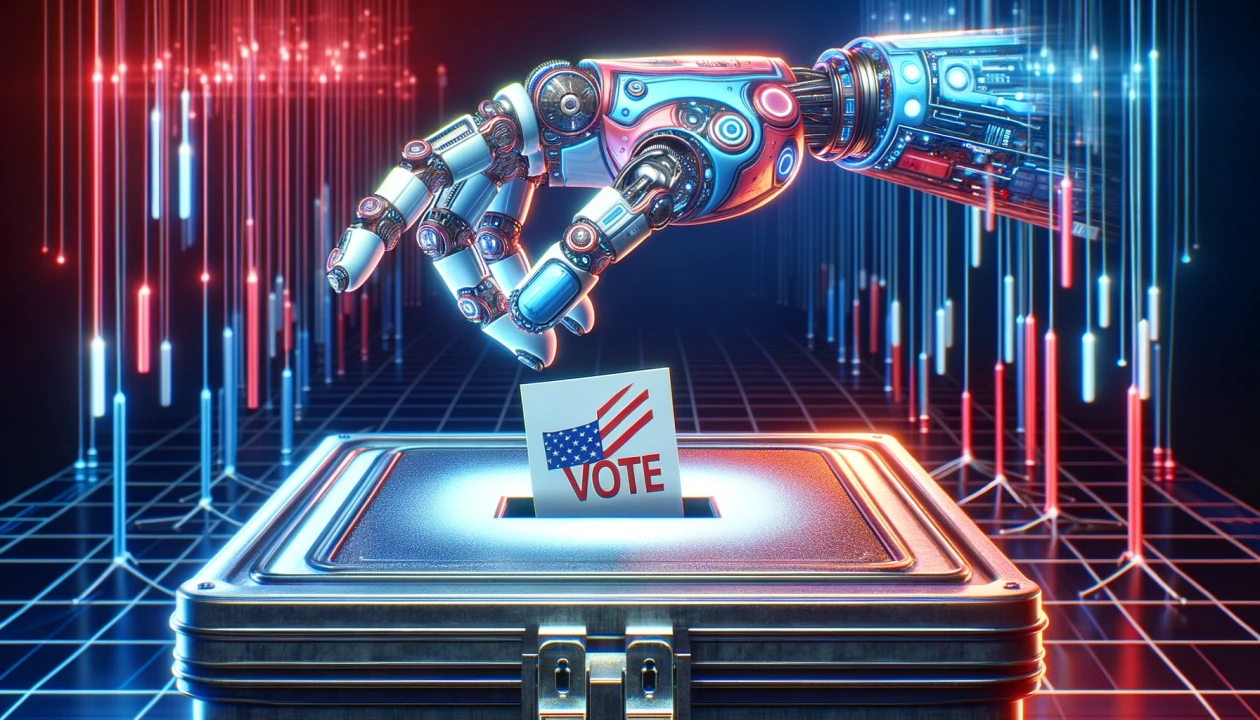In the rapidly evolving landscape of modern elections, artificial intelligence (AI) has emerged as a game-changing force, transforming the strategies and tactics employed by political campaigns. As the 2024 US elections unfold, both parties are increasingly leaning on AI to amplify their reach, tailor their messages, and engage with voters in ways that were once unimaginable. This blog explores the diverse ways AI is shaping election dynamics without favoring any side.
AI-Powered Video Analysis for Content Optimization
In the age of social media and online video consumption, campaign teams are utilizing AI to maximize the impact of their video content. AI-powered video analysis tools evaluate viewer engagement metrics, facial expressions, and audience reactions to determine which types of content resonate most effectively with different voter segments. This helps campaigns continually refine their messages and visual presentations to capture public attention.
By analyzing each frame of campaign videos, AI is providing insights into how to enhance lighting, language, tone, and even background visuals to optimize viewer impact. AI models learn what specific emotions a candidate’s speeches evoke and can generate suggestions to adjust messaging or delivery to appeal to various voter bases. This technology-driven approach has become crucial for keeping audiences interested in the face of relentless information overload.
Natural Language Processing for Automated Voter Interaction
Natural Language Processing (NLP) plays a vital role in automating voter interactions, providing timely responses to questions and engaging voters on a personal level. Chatbots driven by NLP can be deployed across various platforms, such as campaign websites, messaging apps, and social media, to provide answers to voters’ questions about campaign policies, rally schedules, and more.
With NLP, campaigns are creating more interactive experiences for voters, offering real-time responses that are tailored to individual queries. The technology understands voter concerns, directs them to relevant campaign information, and fosters a sense of direct interaction with the candidate, all without requiring a human operator. This makes it possible to address millions of voters simultaneously, scaling voter engagement like never before.
Sentiment Analysis on Social Media for Real-Time Strategy Adjustments
Social media has become a battleground where political sentiments are shaped, challenged, and amplified. AI-driven sentiment analysis tools are now essential for campaigns to gauge the mood of the electorate. By monitoring and analyzing discussions on platforms like Twitter, TikTok, and Facebook, AI systems can detect shifts in voter sentiment in real time.
Campaign teams use these insights to tailor their messages, amplify popular narratives, or diffuse emerging negative sentiments. The ability to detect dissatisfaction or enthusiasm around key issues allows for on-the-fly strategic adjustments that can significantly influence public perception. By leveraging AI for sentiment analysis, campaigns can more accurately align their messages with voter priorities and capitalize on emerging trends.
Micro-Targeting Voter Groups Using AI-Driven Data Analytics
One of the major shifts in campaigning brought about by AI is the ability to micro-target voter groups with precision. AI-driven data analytics is enabling campaigns to segment the electorate into hyper-specific groups based on demographics, past voting behavior, social media activity, and even online shopping preferences. This information allows campaigns to tailor highly customized messages that speak directly to the concerns of individual voter segments.
AI models analyze vast troves of data to find hidden correlations, identifying likely swing voters, highly-engaged supporters, or potential donors. Campaign teams can then deliver customized advertisements or communication materials to these groups, increasing the likelihood of voter mobilization. The personalized approach that AI enables stands in stark contrast to the broader, more generalized messaging of previous decades, making outreach more relevant and effective.
AI-Generated Deepfake and Meme Content for Engagement
AI-generated content, including deepfakes and memes, is being used creatively to increase voter engagement. Deepfake technology, while controversial, is being leveraged in controlled scenarios for campaign skits and promotional videos that add a level of humor or novelty, resonating particularly with younger audiences. On the other hand, AI-generated memes are used to create shareable, easily digestible content that can spread campaign messages organically.
These AI-powered tools allow campaigns to tap into the cultural zeitgeist, utilizing humor and digital creativity to generate positive engagement. However, they also raise ethical concerns around misinformation, which both sides must navigate carefully. Balancing the use of AI-generated content to enhance engagement while maintaining transparency is a new challenge for campaigns as they strive to leverage this technology effectively.
Predictive Modeling to Identify Potential Donors
Fundraising is an integral aspect of political campaigns, and AI is making it more effective than ever. Predictive modeling tools analyze historical donation data, voter demographics, and social behavior to identify potential donors and assess their likelihood of contributing to the campaign. AI can determine the ideal time to reach out, the preferred communication channel, and even the specific message that is most likely to result in a donation.
With these insights, campaigns are able to focus their fundraising efforts more efficiently, ensuring that resources are directed towards individuals with the highest probability of contributing. The use of AI in fundraising is transforming how campaigns manage their finances, making it possible to identify previously untapped donor groups and increase overall funding.
Fact-Checking and Misinformation Detection with AI
With the growing prevalence of misinformation, fact-checking has become a crucial part of any election campaign. AI-powered fact-checking tools are now essential in real-time identification of false claims, whether they originate from political opponents, news sources, or social media users. AI can quickly cross-reference claims against verified databases, providing campaign teams with timely information to counter misinformation.
AI is also being used to detect misleading information aimed at undermining the campaign. By analyzing text patterns, images, and videos, AI systems can flag potentially harmful content that could influence voters’ opinions. This proactive approach to misinformation management is helping campaigns stay ahead in a landscape where information moves at lightning speed.
AI-Based Image Recognition for Event Security
The safety of campaign events is a top priority, and AI-powered image recognition systems are playing a key role in event security. Image recognition technology is used to monitor crowds, detect suspicious activity, and ensure the safety of candidates and attendees. This technology scans live video feeds and identifies potential threats, allowing security teams to respond quickly.
AI-driven image recognition also helps campaigns maintain a secure environment for supporters. By identifying individuals with restricted access or flagging unusual behavior, AI contributes to a safer campaign experience, helping both candidates and their teams focus on engaging with voters rather than worrying about security threats.
Optimizing Social Media Presence with AI on Platforms like TikTok
Platforms like TikTok have become major tools for reaching younger voters, and AI is being used to optimize campaigns’ social media presence on these platforms. AI tools analyze trending topics, viral challenges, and audience preferences to create tailored content that captures voters’ attention. By staying attuned to the latest trends, campaigns can develop content that is timely, relevant, and more likely to resonate with target audiences.
AI also helps determine the optimal posting schedule, the type of content (e.g., video, meme, text), and the ideal tone for each platform. This strategic use of AI ensures that campaign messages are delivered at the right time, in the right format, and to the right audience, increasing their chances of reaching and influencing voters.
Real-Time Voter Sentiment Analysis to Gauge Public Reaction
Throughout the election cycle, candidates and their teams must gauge public reaction to campaign events, debates, and policy announcements. AI is making it possible to analyze voter sentiment in real time, providing insights that enable campaigns to understand how their actions are being perceived.
By using AI to monitor online discussions, news reports, and social media comments, campaigns can assess the impact of major events almost instantaneously. This helps campaign teams pivot when necessary, capitalizing on positive momentum or addressing any issues that may arise. Real-time sentiment analysis is becoming an indispensable tool for campaigns to keep their finger on the pulse of public opinion.
Data-Driven Strategy Adjustments and Personalization
AI’s data-driven approach has given campaigns an unprecedented ability to adjust their strategies with precision. Every voter interaction, social media post, campaign rally, and media appearance generates data that can be analyzed to improve overall strategy. AI takes this vast amount of information and turns it into actionable insights, allowing campaigns to personalize their approach based on what works and what doesn’t.
Through AI, campaigns can now determine which regions need more attention, which messages resonate with different communities, and which issues voters care about the most. This level of personalization not only strengthens voter engagement but also enhances the overall efficiency of the campaign, ensuring that every action taken is backed by data.
Challenges of AI in Political Campaigning
While AI offers numerous benefits to political campaigns, its use also comes with certain challenges. Ethical concerns around data privacy, misinformation, and the manipulation of voter behavior are growing as campaigns employ increasingly advanced AI tools. The risk of AI-generated content, such as deep fakes, being used maliciously has led to calls for clearer regulations on how AI can be used in elections.
There is also a risk of over-reliance on AI, where campaigns may focus too heavily on data-driven strategies and lose the human touch that voters often value. Balancing the use of AI to enhance efficiency while maintaining genuine human connections is a delicate line that campaigns must navigate.
AI and the Future of Campaigning
The 2024 US elections are a clear demonstration of AI’s growing influence in political campaigns, and this trend is likely to continue. AI is fundamentally reshaping how campaigns reach and engage voters, providing new opportunities for personalization, efficiency, and insight-driven strategies. As both sides leverage AI to their advantage, the impact on voter behavior and election outcomes is profound.
Looking to the future, AI is poised to become an even more integral part of the election landscape. Innovations in AI-driven technologies, such as advanced NLP models, predictive analytics, and personalized content generation, will further refine how campaigns communicate with voters. The challenge for future campaigns will be to use these tools responsibly, ensuring that technology enhances democracy rather than undermines it.
Conclusion
AI has undeniably become a central pillar in the strategies for the 2024 US elections, offering campaigns the ability to reach voters in new and more effective ways. From micro-targeting voter groups to real-time sentiment analysis, AI is enabling both sides to fine-tune their strategies for maximum impact. While AI’s role in campaigning is transforming election dynamics, it is up to the campaigns, voters, and regulators to ensure that this technology is used ethically and transparently.
As Artificial Intelligence continues to evolve, its influence on political campaigns will only grow. Whether it’s optimizing content, enhancing security, or personalizing voter interactions, AI has set the stage for a new era of electioneering—one where data, personalization, and automation redefine how candidates connect with voters. The 2024 US elections are just the beginning of this AI-driven transformation, heralding a future where technology and democracy intersect in increasingly complex and powerful ways.










